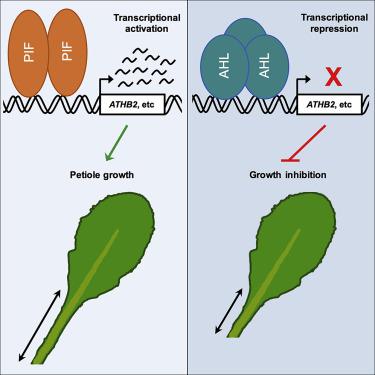当前位置:
X-MOL 学术
›
Curr. Biol.
›
论文详情
Our official English website, www.x-mol.net, welcomes your
feedback! (Note: you will need to create a separate account there.)
AT-Hook Transcription Factors Restrict Petiole Growth by Antagonizing PIFs.
Current Biology ( IF 8.1 ) Pub Date : 2020-03-19 , DOI: 10.1016/j.cub.2020.02.017 David S Favero 1 , Ayako Kawamura 2 , Michitaro Shibata 2 , Arika Takebayashi 2 , Jae-Hoon Jung 3 , Takamasa Suzuki 4 , Katja E Jaeger 5 , Takashi Ishida 2 , Akira Iwase 2 , Philip A Wigge 5 , Michael M Neff 6 , Keiko Sugimoto 7
Current Biology ( IF 8.1 ) Pub Date : 2020-03-19 , DOI: 10.1016/j.cub.2020.02.017 David S Favero 1 , Ayako Kawamura 2 , Michitaro Shibata 2 , Arika Takebayashi 2 , Jae-Hoon Jung 3 , Takamasa Suzuki 4 , Katja E Jaeger 5 , Takashi Ishida 2 , Akira Iwase 2 , Philip A Wigge 5 , Michael M Neff 6 , Keiko Sugimoto 7
Affiliation

|
Upon detecting abiotic or biotic stress, plants generally reduce their growth, enabling resources to be conserved and diverted to stress response mechanisms. In Arabidopsis thaliana, the AT-hook motif nuclear-localized (AHL) transcription factor family has been implicated in restricting rosette growth in response to stress. However, the mechanism by which AHLs repress growth in rosettes is unknown. In this study, we establish that SUPPRESSOR OF PHYTOCHROME B4-#3 (SOB3) and other AHLs restrict petiole elongation by antagonizing the growth-promoting PHYTOCHROME-INTERACTING FACTORs (PIFs). Our data show that high levels of SOB3 expression lead to a short-petiole phenotype similar to that conferred by removal of PIF4. Conversely, the dominant-negative sob3-6 mutant has long petioles, a phenotype which is PIF-dependent. We further show that AHLs repress the expression of many PIF-activated genes, several of which are involved in hormone-mediated promotion of growth. Additionally, a subset of PIF-activated, AHL-repressed genes are directly bound by both SOB3 and PIFs. Finally, SOB3 reduces binding of PIF4 to shared target loci. Collectively, our results demonstrate that AHLs repress petiole growth by antagonizing PIF-mediated transcriptional activation of genes associated with growth and hormone pathways. By elucidating a mechanism via which the stress-responsive AHL transcription factor family influences growth in petioles, this study identifies a key step in the gene regulatory network controlling leaf growth in response to the environment.
中文翻译:

AT钩转录因子通过拮抗PIF来限制叶柄生长。
一旦检测到非生物或生物胁迫,植物通常会降低其生长,从而使资源得以保存并转移至胁迫响应机制。在拟南芥中,AT钩基序核定位(AHL)转录因子家族已被认为可以限制莲座丛对压力的生长。但是,AHL抑制玫瑰花环生长的机制尚不清楚。在这项研究中,我们建立了植物色素B4-#3(SOB3)和其他AHL的抑制剂通过拮抗促进生长的植物色素相互作用因子(PIFs)来限制叶柄伸长。我们的数据表明,高水平的SOB3表达导致短叶柄表型,类似于去除PIF4所产生的表型。相反,显性阴性的sob3-6突变体具有长叶柄,这种表型是PIF依赖性的。我们进一步表明,AHL抑制许多PIF激活基因的表达,其中一些参与激素介导的生长促进。另外,PIF激活的,AHL抑制的基因的子集直接与SOB3和PIF结合。最后,SOB3减少了PIF4与共享目标基因座的结合。总的来说,我们的结果表明,AHL通过拮抗PIF介导的与生长和激素途径相关的基因的转录激活来抑制叶柄的生长。通过阐明胁迫响应性AHL转录因子家族影响叶柄生长的机制,本研究确定了基因调控网络中控制叶片响应环境生长的关键步骤。另外,PIF激活的,AHL抑制的基因的子集直接与SOB3和PIF结合。最后,SOB3减少了PIF4与共享目标基因座的结合。总的来说,我们的结果表明,AHL通过拮抗PIF介导的与生长和激素途径相关的基因的转录激活来抑制叶柄的生长。通过阐明应力响应性AHL转录因子家族影响叶柄生长的机制,本研究确定了基因调控网络中控制叶片响应环境生长的关键步骤。另外,PIF激活的,AHL抑制的基因的子集直接与SOB3和PIF结合。最后,SOB3减少了PIF4与共享目标基因座的结合。总的来说,我们的结果表明,AHL通过拮抗PIF介导的与生长和激素途径相关的基因的转录激活来抑制叶柄的生长。通过阐明胁迫响应性AHL转录因子家族影响叶柄生长的机制,本研究确定了基因调控网络中控制叶片响应环境生长的关键步骤。我们的结果表明,AHL通过拮抗PIF介导的与生长和激素途径相关的基因的转录激活来抑制叶柄的生长。通过阐明胁迫响应性AHL转录因子家族影响叶柄生长的机制,本研究确定了基因调控网络中控制叶片响应环境生长的关键步骤。我们的结果表明,AHL通过拮抗PIF介导的与生长和激素途径相关的基因的转录激活来抑制叶柄的生长。通过阐明应力响应性AHL转录因子家族影响叶柄生长的机制,本研究确定了基因调控网络中控制叶片响应环境生长的关键步骤。
更新日期:2020-04-20
中文翻译:

AT钩转录因子通过拮抗PIF来限制叶柄生长。
一旦检测到非生物或生物胁迫,植物通常会降低其生长,从而使资源得以保存并转移至胁迫响应机制。在拟南芥中,AT钩基序核定位(AHL)转录因子家族已被认为可以限制莲座丛对压力的生长。但是,AHL抑制玫瑰花环生长的机制尚不清楚。在这项研究中,我们建立了植物色素B4-#3(SOB3)和其他AHL的抑制剂通过拮抗促进生长的植物色素相互作用因子(PIFs)来限制叶柄伸长。我们的数据表明,高水平的SOB3表达导致短叶柄表型,类似于去除PIF4所产生的表型。相反,显性阴性的sob3-6突变体具有长叶柄,这种表型是PIF依赖性的。我们进一步表明,AHL抑制许多PIF激活基因的表达,其中一些参与激素介导的生长促进。另外,PIF激活的,AHL抑制的基因的子集直接与SOB3和PIF结合。最后,SOB3减少了PIF4与共享目标基因座的结合。总的来说,我们的结果表明,AHL通过拮抗PIF介导的与生长和激素途径相关的基因的转录激活来抑制叶柄的生长。通过阐明胁迫响应性AHL转录因子家族影响叶柄生长的机制,本研究确定了基因调控网络中控制叶片响应环境生长的关键步骤。另外,PIF激活的,AHL抑制的基因的子集直接与SOB3和PIF结合。最后,SOB3减少了PIF4与共享目标基因座的结合。总的来说,我们的结果表明,AHL通过拮抗PIF介导的与生长和激素途径相关的基因的转录激活来抑制叶柄的生长。通过阐明应力响应性AHL转录因子家族影响叶柄生长的机制,本研究确定了基因调控网络中控制叶片响应环境生长的关键步骤。另外,PIF激活的,AHL抑制的基因的子集直接与SOB3和PIF结合。最后,SOB3减少了PIF4与共享目标基因座的结合。总的来说,我们的结果表明,AHL通过拮抗PIF介导的与生长和激素途径相关的基因的转录激活来抑制叶柄的生长。通过阐明胁迫响应性AHL转录因子家族影响叶柄生长的机制,本研究确定了基因调控网络中控制叶片响应环境生长的关键步骤。我们的结果表明,AHL通过拮抗PIF介导的与生长和激素途径相关的基因的转录激活来抑制叶柄的生长。通过阐明胁迫响应性AHL转录因子家族影响叶柄生长的机制,本研究确定了基因调控网络中控制叶片响应环境生长的关键步骤。我们的结果表明,AHL通过拮抗PIF介导的与生长和激素途径相关的基因的转录激活来抑制叶柄的生长。通过阐明应力响应性AHL转录因子家族影响叶柄生长的机制,本研究确定了基因调控网络中控制叶片响应环境生长的关键步骤。











































 京公网安备 11010802027423号
京公网安备 11010802027423号